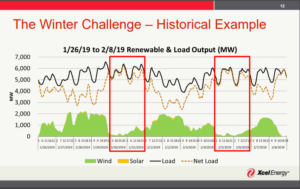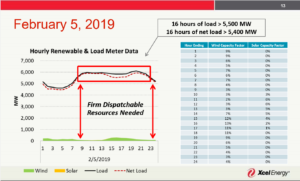Xcel Energy warns of possible power outages similar to South Australia due to growing renewable presence
Buried within Xcel Energy’s latest resource planning documents lies a dire warning about the rapidly growing presence of wind and solar energy sources on Minnesota’s electrical grid. [Appendix J of the document].
According to the state’s largest electric utility company, Minnesota’s race to dismantle large power facilities – like coal facilities such as Sherco and AS King, and even some hoping for the toppling of the state’s two carbon-free nuclear facilities – in favor of intermittent renewable energy sources like wind and solar is creating conditions more susceptible to state-wide power outages.
Xcel warns that the growing presence of remote energy sources like wind and solar could trigger power outages similar to what occurred in southern Australia in 2016. As the utility company notes:
[I]n 2016, the Australia power system experienced storm damage that forced several transmission lines to open. The wind farms that were being relied upon on at that time… started to trip offline – resulting in a large-scale power outage in southern Australia. While there are standards and practices in place in the Eastern Interconnection, MISO and Minnesota transmission systems to help avoid this same scenario, the rapid escalation of renewable resources and the earlier than expected retirement of baseload generation places a greater strain on the transmission system to deliver more remote sources of generation, and increases the likelihood of events similar to the Australia power outage occurring on the local transmission system.
[My Emphasis]
The Australian Energy Market Operator (AEMO) promptly contradicted attempts to undermine the role renewables played in the event – such as by The Guardian, which flat out denied renewables had anything to do with the power outage – when it published a report in 2017 directly blaming wind turbines, stating it was an “action of a control setting responding to multiple disturbances that led to the Black System.”
If not for wind energy being on the grid, the Australian blackout would have never occurred.
The storm that hit Australia in 2016 resulted in over 800,000 Australians losing power for hours – and it would be wrong to think that this kind of event couldn’t happen here.
In fact, Xcel details at least four recent examples of weather conditions in Minnesota taking wind and solar off the grid entirely – which, interestingly, didn’t always involve extreme weather.
Minnesota Is Not the Place for Unreliable Energy Sources
In Minnesota, it doesn’t take the worst storm in 50 years to knock renewable energy sources off the grid.
Here are four examples, provided by Xcel, showcasing the unreliable nature of wind and solar energy coming in at least three different scenarios – a major winter storm producing below -20 degree temperatures, a windless winter day with heavy snow coverage, and two windless summer days. They help explain why Minnesota cannot rely on renewable energy sources alone to supply electricity on a consistent basis:
1. 2019 Polar Vortex:
The “Polar Vortex” occurred from January 28 to February 1, 2019. As Xcel notes, it consisted of “extreme cold temperatures over a sustained period of time across the northern United States… with temperatures falling well below -20 degrees F in some areas.”
Xcel states that on January 30th, “the vast majority of wind turbines shut down due to extreme cold temperatures, and output dropped sooner than the forecast had predicted. As a result, firm dispatchable resources were needed to fill the gap left by the forecast error and lack of wind.” “Firm dispatchable resources” is essentially a different way of saying coal, natural gas, and nuclear power.
And while solar energy typically operates best in colder, winter months, panels across the state experienced difficulties due to high amounts of snow coverage and, as a result, generated electricity well below their forecasts.

What resulted was a near disaster.
With such a substantial power shortage during one of the coldest days on record, the grid operator responsible for ensuring energy reliability in Minnesota – the Midcontinent Independent System Operator (MISO) – had to rely on reserve electricity imports from neighboring regional operators, which it “nearly exhausted at one point in order to avoid a critical deficiency in available energy.”
Had Minnesota had a little more renewable, intermittent energy on the grid, and a little less coal, natural gas and nuclear to support the sudden shortage in supply, the hundreds of people who experienced power outages during the Polar Vortex might’ve been hundreds of thousands.
2. February 5, 2019:
On this occasion, Xcel notes that “While the polar vortex involved extreme weather conditions that affected wind production especially, February 5, 2019 was a normal winter day that offers another example where” renewable energy output was essentially zero for nearly 16 hours, and traditional sources like coal, natural gas, and nuclear power supplied almost the entirety of electricity demand.
The utility goes on to say that “During this period, all wind and solar resources on the system combined to have an average hourly capacity factor of six percent, and there were particular hours when neither wind nor solar resources had a capacity factor greater than three percent.”

When an energy source can only generate at 6 percent potential as a maximum output, it would take hundreds of thousands of megawatts (MW) of capacity to ensure demand is being met.
In fact, Xcel says it would need “in excess of 180,000 MW” of combined wind and solar to meet demand in a 100 percent renewable world, and even, Xcel notes, “this amount of renewable generation may be insufficient given the declining capacity value of renewable generation, as discussed above, and the probability there will be times with extremely low levels of wind and sunlight.”
[For comparison, Xcel Energy currently owns around 19,000 MW of total capacity in the country].
The capital investment alone for 180,000 MW of wind and solar capacity would be over $225 billion.
3 and 4. July 2018 / May 2019:
Renewables in Minnesota can also operate poorly in the summer months.
On one occasion in July 2018, Xcel details an “especially windless day” when “in one hour, the wind turbines that were online were taking more power than they were producing. This hour was also part of an approximately 110 hour sustained stretch in which the combined output of all wind resources in the MISO footprint fell well below the accredited values used in present planning processes.”
Xcel continues, explaining that “During the 8:00 a.m. hour, the entire MISO wind portfolio (over 17,000 MW at that time) had a combined output of minus 11 MW – meaning the wind turbines that were online were taking more power than they were producing.”
This example should disqualify any ideas proclaiming that “the wind is blowing somewhere.” The entire wind fleet in the MISO region – spanning from Canada to the Gulf of Mexico – was collectively using more power than it was producing, and the entire energy grid was relying primarily on coal, natural gas, hydro and nuclear power.
And once more, Xcel notes that in May of 2019 the utility “again encountered sustained low wind conditions in early 2019, with 370 hours of wind production below accredited values before May 1.”
Renewable Energy Is Unreliable and Susceptible to Power Outages
If the above examples make anything clear, it’s that energy sources that rely on the weather to produce electricity are too intermittent to supply demand 100 percent of the time.
And no amount of battery storage or overbuilding of the system will make a difference.
A University of Minnesota Research Brief studied possible solutions to meet the challenges presented by intermittent energy sources like wind and solar by either installing battery storage or overbuilding renewable energy by 150% to meet demand, and concluded that “no matter the scenario, the study found that the use of fossil fuels would still be needed to meet peak demand in cold climates like Minneapolis and Fort Collins.” It continued, explaining that “renewable energy cannot be produced at the rate needed to meet demand during the coldest months.”
Xcel agrees.
In the “key takeaways” of the data shown in Appendix J of the latest resource plan published, the utility included the following:
As this data shows, today’s intermittent generating resources [wind and solar] cannot alone meet demand at all times of the year, at least without excessive costs. Even during historically good times of the year for renewable generation on the Company’s system, the availability of these resources is inexorably tied to the variability of weather patterns, and at times they are simply not available. Additionally… Current battery storage systems are limited (typically to 4 hour discharge periods) with significant time needed to recharge. Unless overbuilt many times over, these resources would not be able to provide energy for the full duration of such events; they also may not be able to recharge fast enough to be a viable resource during the consecutive periods of low renewable output.
[My emphasis]
With more renewable energy capacity on the grid, events like the ones described above will become more and more likely to result in power outages for hundreds of thousands of people living in Minnesota. No matter how much renewable capacity is on the grid, traditional and large-scale power facilities like coal, natural gas, and nuclear will always be necessary to maintain reliability and protect against power outages similar to those that occurred in South Australia.